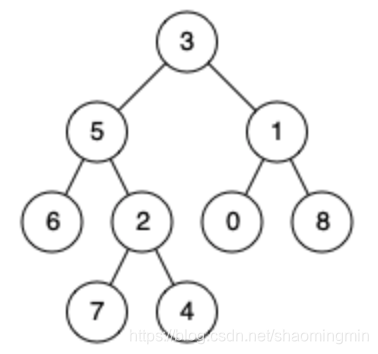本文主要是介绍Java数组转为二叉树-由LeetCode236题(求二叉树的最近公共祖先)引出的问题拓展,希望对大家解决编程问题提供一定的参考价值,需要的开发者们随着小编来一起学习吧!
直接上题目
给定一个二叉树, 找到该树中两个指定节点的最近公共祖先。
百度百科中最近公共祖先的定义为:“对于有根树 T 的两个结点 p、q,最近公共祖先表示为一个结点 x,满足 x 是 p、q 的祖先且 x 的深度尽可能大(一个节点也可以是它自己的祖先)。”
例如,给定如下二叉树: root = [3,5,1,6,2,0,8,null,null,7,4]
下图是该数组转换成二叉树的形状

来源:力扣(LeetCode)
链接:https://leetcode-cn.com/problems/lowest-common-ancestor-of-a-binary-tree
数组转二叉树方法Java代码,递归方法实现
public static TreeNode ArrToTree(Integer []arr, int index)
{//申请一个根结点TreeNode root = null;if (index<arr.length) {Integer value = arr[index];if (value == null) {return null;}//自顶向下构建二叉树的每一层root = new TreeNode(value);root.left = ArrToTree(arr, 2*index+1);root.right = ArrToTree(arr, 2*index+2);return root;}return root;
}
完成代码如下
package LeetCode236;import java.util.*;class TreeNode {int val;TreeNode left;TreeNode right;TreeNode(int x) { val = x; }
}public class Solution {static Map<Integer, TreeNode> parent = new HashMap<Integer, TreeNode>();static Set<Integer> visited = new HashSet<Integer>();public static void dfs(TreeNode root) {if (root.left != null) {parent.put(root.left.val, root);dfs(root.left);}if (root.right != null) {parent.put(root.right.val, root);dfs(root.right);}}public static TreeNode lowestCommonAncestor(TreeNode root, TreeNode p, TreeNode q) {dfs(root);while (p != null) {visited.add(p.val);p = parent.get(p.val);}while (q != null) {if (visited.contains(q.val)) {return q;}q = parent.get(q.val);}return null;}public static TreeNode ArrToTree(Integer []arr, int index){TreeNode root = null;if (index<arr.length) {Integer value = arr[index];if (value == null) {return null;}root = new TreeNode(value);root.left = ArrToTree(arr, 2*index+1);root.right = ArrToTree(arr, 2*index+2);return root;}return root;}public static void main(String[] args) {Integer nums[]={3,5,1,6,2,0,8,null,null,7,4};TreeNode root=ArrToTree(nums, 0);TreeNode p=new TreeNode(5);TreeNode q=new TreeNode(4);System.out.println(lowestCommonAncestor(root,p,q).val);}
}这篇关于Java数组转为二叉树-由LeetCode236题(求二叉树的最近公共祖先)引出的问题拓展的文章就介绍到这儿,希望我们推荐的文章对编程师们有所帮助!




